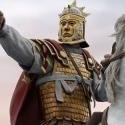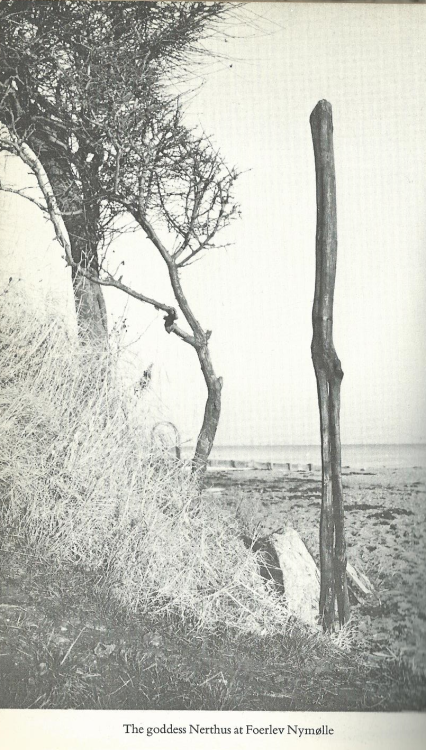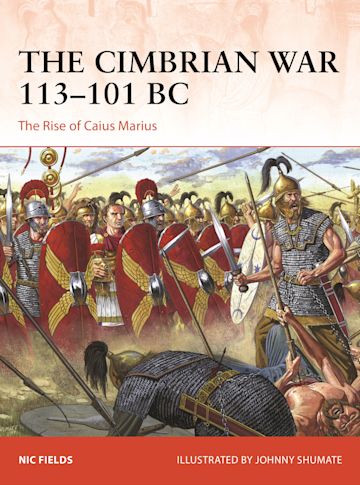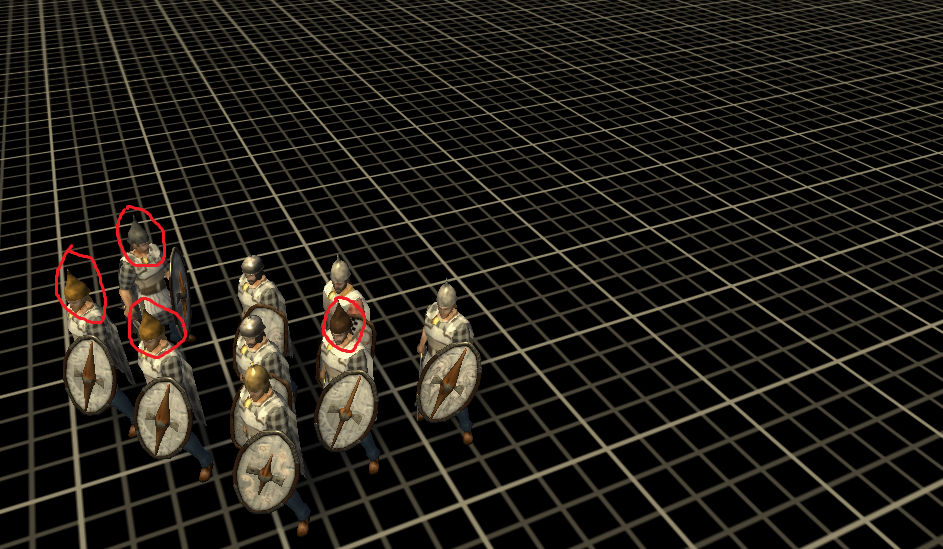-
Posts
446 -
Joined
-
Last visited
-
Days Won
3
Everything posted by Ultimate Aurelian
-

Civ: Germans (Cimbri, Suebians, Goths)
Ultimate Aurelian replied to wowgetoffyourcellphone's topic in Delenda Est
Perhaps something like this (1st Century BC statue from Possendorf.) It was apparently around 90 centimeters tall. Those were larger, but more crude in style: https://en.wikipedia.org/wiki/Braak_Bog_Figures -

Civ: Germans (Cimbri, Suebians, Goths)
Ultimate Aurelian replied to wowgetoffyourcellphone's topic in Delenda Est
I guess this is following the ''battle sanctuary'' concept The statue might be too late, the equipment (Kite shield, conical helmet with mail aventail) appears to be from the early middle ages. -

===[TASK]=== (early) German Shield Patterns
Ultimate Aurelian replied to wowgetoffyourcellphone's topic in Official tasks
Could be mostly unpainted but with small player color designs. Or just painted in solid player color (With no patterns) I think most shields for citizen units could have the wooden spina instead of a metal boss. Elite would get metal bosses (The simple round one or the one who is just a metal reinforcement on the wooden spina) Champions would get metal bosses (Simple round one and pointy round one) and have metal rims on shields -
Out of curiosity,is there a particular reason the color red was chosen for Xiongnu?
-
https://www.gov.mb.ca/sd/pubs/parks-protected-spaces/park_info/whiteshell_petro.pdf https://en.wikipedia.org/wiki/Petroform Could be a reference but their exact relationship with ancient Anishinabee (Or when they were built) is not clear. Some are tentatively dated to 500 AD based on nearby archeological finds.
-
I like the new forge personally, i feel it's more accurate without the big chimney. I'm not sure the wooden totems fit, as far as i know they were mainly used in the Northwest.
-
https://en.wikipedia.org/wiki/Onager_(weapon) If this is true the Onager might be too late for the Principate Romans, (But would fit a possible late Roman civilization).
-
-
I think it would fit well for the Xiognu. From what i read the Scythians were not really shamanistic, they had a polytheistic religion with some similarities to other indo-european ones. This could be a reference for Enaree (Beardless man on the right)
-

Civ: Germans (Cimbri, Suebians, Goths)
Ultimate Aurelian replied to wowgetoffyourcellphone's topic in Delenda Est
Not sure why the back of the lower floor is made of stone then. I think it might be better to use the same texture all around, since I don't think they used stone for buildings in that period. -

Civ: Germans (Cimbri, Suebians, Goths)
Ultimate Aurelian replied to wowgetoffyourcellphone's topic in Delenda Est
Are those two different versions or is the back of the building made of a different material than the front? -

Germans [Cimbri]redesign for TM
Ultimate Aurelian replied to Lion.Kanzen's topic in Rise of the East
Those sound like Celtic names. Do you think it's possible they spoke a Celtic language? -

Germans [Cimbri]redesign for TM
Ultimate Aurelian replied to Lion.Kanzen's topic in Rise of the East
R2TW Symbol: Based on the Gundestrup Cauldron, maybe not the best choice since it was imported from somewhere else. Cover from a book that will come out in August: -

Germans [Cimbri]redesign for TM
Ultimate Aurelian replied to Lion.Kanzen's topic in Rise of the East
They could have an archer instead of slinger, champion cavalry with sword instead of spear and perhaps a citizen swordsman instead of club/axe infantry. Not sure if they should keep wolf warriors. They would have more celtic influence and possibly a more armored roster (Elite infantry has metal and wood helmets, champions have chainmail and helmets). Buildings i think would be more or less the same, although if you want to give them a nomadic playstyle you might have to change it to tents? -

Civ: Germans (Cimbri, Suebians, Goths)
Ultimate Aurelian replied to wowgetoffyourcellphone's topic in Delenda Est
Possible specific names for units ; i used wiktionary and some names from total war mods Spearman: Harjaz (Warrior or commander) Warjaz (Defender, Citizen) Wīgamann (Warrior, Champion) Militia Clubman: Slahandz (Striker, Killer) Breutandz (Destroyer, breaker, Smasher) Warjaz (Defender, Citizen) Axeman: Slahandz (Striker, Killer) Mōdagaz (Brave, courageous) Akwisīwaldaz (Axe-Wielder) Javelinist: Jungilingaz (Youth) Slinger: Slingwandz (Slinger) Scout: Sōkijandz (Seeker) Cavalry javelinist: Welwô (Plunderer, robber) Cavalry Spearman Ridanz Champion Swordsman: Herunautaz (Sword owner) Gahlaibô (Messmate, comrade, companion) Sagjaz (Retainer, Warrior) Kuningasþegnaz (King's retainer, King's servant) Þegnaz (retainer, servant) Herthaganautaz (Hearth Companion) Haliþaz (Hero) Champion cavalry: Erlaz (Noble) Marhafrawjô (Horse Lord) Ram: Rammaz (Ram as in the animal; there is no evidence the word was associated with siege engines like in the classical world) Gatabreutandz (Gate smasher) Wolf Warrior: Wulfaharjaz (wolf Warrior) Wulfahadinaz (Attempted early form of Ulfheodnar) Blōþądrinkandz (Blood drinker, from Paul the Deacon's account of the Lombard "cynocephali" Wōdaharjaz (Frenzied warrior) Villager: Karilaz (Freeman) Slave: Þewaz Merchant: Wihslōndz (Trader) Kaupô (Inkeeper, Merchant; Borrowed from Latin) Priest: Gudjô Wīhōn Haljarūnō (Witch, sorceress; could be used in case they get a priestess instead of priest) Fishing boat: Fiskarijasbaitaz (Fisherman's boat) Trading boat: Rinaskaupô (Rine Merchant) Pig: Swīną Cow: Kūz Sheep: Skēpą Reconstructions of hero names: Ariovistus: Ariouistos (Celtic) Harjafristaz (Germanic; means army leader) Maroboodus: Marobodwos (Celtic, Great raven, great war god) Marabadwaz (Germanic, great battle) Marabodwaz (Germanic) Ballomar: Ballomaros (Celtic, great limb) Balþamerijaz* *The last one is a Proto-Germanic name who survived as the Galician ''Baldomar'', it is a fusion of balþaz (“bold”) and mērijaz (“great; famous”). I have not seen anyone else suggest this origin for Ballomar; it is just speculation on my part. -

Civ: Germans (Cimbri, Suebians, Goths)
Ultimate Aurelian replied to wowgetoffyourcellphone's topic in Delenda Est
For clothing maybe something like this: Basic:Wearing only pants, loincloth or naked. Advanced:Barechested or naked with a cloak (From Roman art and Tacitus'descriptions it seems they often wore the cloak without the tunic) Elite:Cloak and tunic. Maybe the champions could have armor; but they have a chance of spawning without it. Other ways to distinguish them from citizen units would be to give them scabbards, some kind of jewelry (The neckchains described in Germania?) and fancier clothes. Possibly use this sort of ''flannel'' pattern. Shields could be used as well: Basic:Oval or Rectangular shield with wooden boss Advanced:Oval, rectangular or hexagonal shield with wooden boss Elite: Oval, rectangular or hexagonal shield; metal reinforced spina or metal boss Champion: Rectangular or hexagonal shield; metal boss with some having reinforced rim For javelin units you'd have: Basic: Wicker Shield Advanced:Small oval or Rectangular shield with wooden boss Elite: Small oval or rectangular shield; metal reinforced spina or metal boss The patterns on the shield could vary according to rank too I think this is would be a good idea for a bonus; maybe could call it ''Furor Teutonicus''. -
References for weapons and armor: https://pinterest.com/siresasa/ancient-scythian-weapons-only-historically-accurat/ https://pinterest.com/siresasa/ancient-scythian-armour-only-historically-accurate/ Various artifacts (Iconography might be useful):https://fi.pinterest.com/siresasa/scythian-antiquities/ It would indeed be a good option for temple or even statue. From what i can find the Ovoo is a Tengrist costume and was not really used by Scythians. For the Huns there is only fragmentary evidence about their religion, both could potentially fit. Seventh century accounts says the Huns on the Caucasus worshipped "T'angri Khan" . Atilla supposedly owned the ''sword of Mars''; so possibly the Huns absorbed the Scythian/Sarmatian sword cult. https://en.wikipedia.org/wiki/Sword_of_Attila
-
Maybe instead of cash crops steppe civs (and possibly some others like Germans) could have a sort of building where they can sell cattle and horses for currency. Or some sort of milk/wool mechanic.
-

Civ: Germans (Cimbri, Suebians, Goths)
Ultimate Aurelian replied to wowgetoffyourcellphone's topic in Delenda Est
Possible specific names for wonder (Words are taken from wiktionary and EB): Samnungozbarwaz (Semnones' grove), Feturasbarwaz (Grove of fetters), Wigasalhs/Gunþīzalhs/Hildīzalhs/Haþauzalhs (Battle-Sanctuary, there are multiple words for battle) According to Caesar they were used by Germans in the Gallic wars: -

Civ: Germans (Cimbri, Suebians, Goths)
Ultimate Aurelian replied to wowgetoffyourcellphone's topic in Delenda Est
Considering the importance of bodies of water for their religion; they could have a sort of religious building that is built on shallows. Maybe a function where you sacrifice units, metal or coin for glory. Or just make it a bonus/tech (Something like you can gather glory at docks or docks can heal) -
It also appears in EB. It is based on a migration period Scandinavian pendant, so maybe not the best choice https://www.metmuseum.org/art/collection/search/473485 On another thread Genava posted some ideas for a sun wheel symbol
-

===[TASK]=== Crowd Sourced - Illyrians (Faction)
Ultimate Aurelian replied to wackyserious's topic in Game Modification
Possibly they could have a pikeman unit https://europabarbarorum.fandom.com/wiki/Illyrioi_Peltophoroi_(Illyrian_Light_Phalanx)






